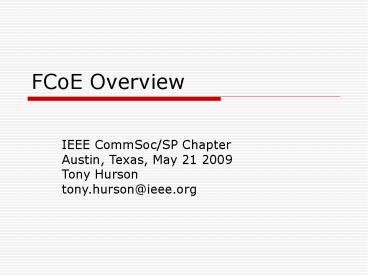FCoE Overview PowerPoint PPT Presentation
Title: FCoE Overview
1
FCoE Overview
- IEEE CommSoc/SP Chapter
- Austin, Texas, May 21 2009
- Tony Hurson
- tony.hurson_at_ieee.org
2
Networked Storage History
3
SANs Latency, Throughput Requirement
4
SCSI Read, Write over FC
5
FC Fabric Port Terminology
6
FC Initialization Flow
- Host (Physical Machine) initiates Fabric Login
with nearest switch FLOGIN receives a VN_Port
ID in return - (Additional entities on same Host e.g. Virtual
Machines may also log into fabric using NPIV
FDISC, each getting a unique VN_Port ID). - (Host may use well-known FC servers to discover
the VN_Port IDs of its Targets and their LUNs). - Host initiates Port Login with chosen Targets
7
FC Routing
8
Ethernet Routing
- Dynamic Scheme Source Learning
- If unicast DstMAC is not in lookup table, flood
frame to all ports except its source port. - Note source port of SrcMAC in lookup table, if
not already present - Age/invalidate lookup entries
- Similar flooding behavior for multicast
- Precludes loops in fabric
9
FC Frame Format
10
FC Classes of Service
- Class 1 dedicated connection obselete
unsupported in FCoE - Class 2 acknowledged, with ACKs from remote
peer. Supported in FCoE, though some link-layer
features (F_RJT, F_BSY) irrelevant. Useful for
large Sequences and sequential devices. - Class 3 unacknowledged, FCoE-supported. Most
prevalent for disk applications. Error recovery
punted to higher (FCP) levels. - Class F inter-switch link only. FCoE-supported
11
Protocol Stack History and Comparison
12
iSCSI SAN Pros and Cons
- For
- Runs over existing, ubiquitous Ethernet, TCP/IP
fabrics. - Internetworking built in.
- Lots of fabric management tools (ready for
enterprise storage?). - Against
- TCP Slow Start impacts I/O latency, throughput
(but newer TCPs are tunable) - Lossy fabrics impact I/O latency through
re-transmission and complicate receive endpoint
data placement. - Bridging to legacy FC SANs slow/expensive because
of TCP termination overhead.
13
Lossless Ethernet via PAUSE
14
FCoE Early Deployment Example
15
FCoE Frame Format
16
FCoE Endpoint Model
17
FCoE Switch Functional Model
18
Converged Ethernet
- AKA Data Center Bridging (DCB). Run up to four
major traffic classes on single 10 GbE fabric. In
order of market prevalence - Networking (TCP/IP, lossy).
- Block Storage (lossless FCoE, or lossless/lossy
iSCSI). - Management (heartbeat traffic, low bandwidth,
but must get through). - Inter-Process Communication (clustered computing
high bandwidth, low latency, lossless preferred).
19
Groundwork for DCB
- IEEE 802.1Qaz ETS DCBX bandwidth allocation
to major traffic classes (Priority Groups) plus
DCB management protocol. - IEEE 802.1Qbb Priority PAUSE. Selectively PAUSE
traffic on link by Priority Group. - IEEE 802.1Qau Dynamic Congestion Notification.
20
IEEE 802.1Qaz Enhanced Transmission Selection
- Support at least 3 Priority Groups/traffic
classes - PGs identified by Priority field of existing
802.1Q VLAN Tag - Configured Bandwidth per PG has 1 resolution
- PG15 has limitless bandwidth (use sparingly!, for
Management) - Work Conservation if the wires free, use it.
21
ETS Configuration Example
- PG0 (Storage) 40 of port b/w
- PG1 (Networking) 20 of port b/w
- PG2 (IPC) 40 of port b/w
- PG15 (mgmt) limitless
- If a PG underutilizes, others can fill the space.
- Typical implementation DWRR.
22
IEEE 802.1Qbb Priority PAUSE
23
IEEE 802.1Qau Dynamic Congestion Control
Background
- Lossless fabrics are prone to congestion
spreading (congestion trees). - Ethernet-FC gateways with their different port
speeds (10 GbE 8 Gbps) are natural bottlenecks. - ETS Work Conservation model adds fuel to fire.
- Solution switches/endpoints notify traffic
sources of incipient congestion, via feedback
messages sources reduce rates accordingly.
24
Congestion Notification in Action
25
Congestion Control at Endpoint Transmit
26
FCoE Summary
- Presents new, but very familiar, PHY and Link
Layers for FC. - Core switching discipline remains FC-SW-5.
- Higher FC layers almost completely unchanged
(thats the legacy value!) - Biggest Ethernet-level requirement lossless
fabric. - Part of Converged Ethernet initiative lots of
ancillary activity at IEEE.
27
Further Reading
- FCoE www.t11.org
- IEEE 802.1Q(azaubb) www.ieee.org
- Thank you! Questions?

